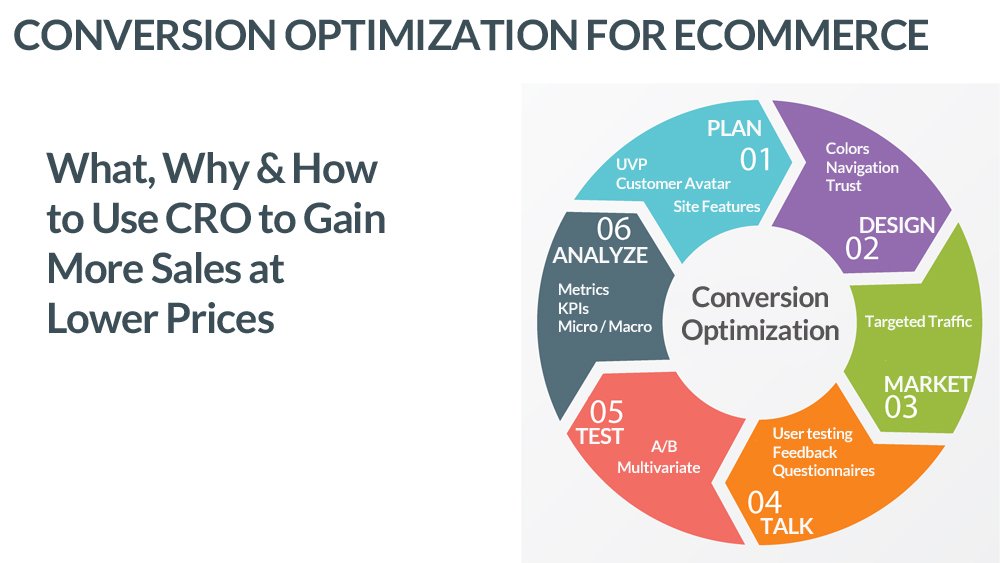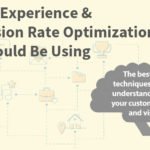As active as I am in ecommerce, I hear the same questions repeatedly asked by those new to online store ownership or those whose sales used to be great but are now experiencing a loss in sales. “Why aren’t site visitors buying?” “Why are my sales dropping?” I recently saw a highly related question in the BigCommerce Facebook group; “What’s the highest converting BigCommerce theme?” I applaud this business owner’s thought process as she plans her store. She’s thinking about conversion rate optimization which is really important to success.
Why is Conversion Rate Optimization (CRO) so important?
In a nutshell, you want as many of your site visitors to convert into buyers. The higher your conversion rate, the more efficient your marketing efforts. Almost everything you do to draw traffic uses your resources whether that resource is your time or your cash. You are in business to make money so the better the profits, or return on investment (ROI), the more money you’ll make.
Conversion Rate science is a big deal
Every large retailer works hard to squeeze every dime out of their marketing dollars. They hire CRO experts and constantly test site visitors for what are often small improvements. On scale, and cumulatively, these changes make a big difference in profitability. Their websites are often used in research studies by Baymard Institute. Baymard Institute exists to research conversion optimization. They define “best practices.”
Can a small business make use of this research and optimize their websites to improve CRO? Absolutely! Quite a few good software programs exist that any size company can use to measure how site visitors react to their website. Google Analytics, Crazy Egg, Hotjar, and Clicktale are all leading software that offers the data store owners need to understand how site visitors interact with your website. Some are free, some are affordable.
Key factors for CRO
There are many components involved in how well your online store converts. I think of it as a four-legged stool. If you’re missing one leg, your stool will wobble and fall.
- Unique Value Proposition (UVP): The UVP is simply the reason why someone wants to buy from you. Retail is a competitive space. What are you offering that offers value to your customers? Is it unique products, great pricing, outstanding customer service, and/or content that helps shoppers make better decisions? How do you make the shopper’s life better, more interesting, or fun? Value is all about perception. When you’re selling something, your customer must see a value to buy and must receive value to buy again, tell their friends, or leave great reviews. A solid UVP is the most important factor to success.
- User Experience (UX): How pleasant and easy is it to navigate your website? Do you steer site visitors towards the desired action? Is your site fast and mobile friendly? Can users find what they need quickly? Is your site attractive? Are your images clear? Does the content describe your products well and answer their questions? Think about the websites you shop at. What do they do well? What could be better? Think like a shopper and, more importantly, how your shoppers want to experience their visit to your website.
- Trust: If your website looks sketchy or is hard to use, visitors will not buy. It’s as simple as that.
- Traffic: If no one sees your site, the rest is moot. Sales will not happen. However, traffic can be a trap. “Traffic” isn’t what you want or need. What you need is targeted traffic. Targeted traffic is defined as people who want and need what you offer. Less traffic that converts well is preferable to more traffic that isn’t interested.
Conversion Rate Optimization – strategic planning
When planning to build or change your store, it is critically important to define what makes your business unique and to really deep dive into how you will accomplish and present your value proposition. Understanding and defining your value chain is the first step of this process.
What is a value chain?
Expert Michael Porter defines the value chain as “A value chain is a set of activities that an organization carries out to create value for its customers.” Here’s a link to a great article that explores the concept of a value chain well.
Your value chain involves everything from what and where you source what you offer, your pricing, shipping and return policies, and customer service. Part of the value chain happens behind the scenes and refers to what you do to provide better product, cheaper, faster and more profitably.
Just as important is how customers perceive your value. Site messaging must consistently convey your value. How will you convey your value proposition? A key aspect of trust is what your customers actually experience. Are you delivering exemplary products and customer service? This is how you deliver value to your customers.
Site design and user experience
Your site design has a dramatic impact on how well it converts visitors into buyers. A good design makes your site easy to use and inspires trust. Here are a few of the major factors:
Color scheme and white space
Your site design needs to be current and clean. Images should be high quality and your site needs plenty of “white space” – defined as areas that do not have text or images. This makes it easier to read and presents your products as the focus of your website. Colors impact emotion. There are many great articles out there about color and psychology. Hunt them out and determine what combination is most appealing to your audience and presents your products well. Call to action buttons, such as “Buy Now” should stand out from the rest of your visual content.
Site feature set
Customers have minimum technology or feature expectations most sites need. Expectations include image zoom and multiple images, as well as a great search. Product filters that narrow choices for browsers are also helpful if relevant to your product mix. Other features enhance the user experience and trust including great product descriptions and reviews, videos, blog content and live chat. Are coupons and discounts available? Do you have a cart recovery program in place? Are you gathering a lot of new subscribers for your email or SMS list?
Ease of use
The rule here – don’t frustrate your visitors! Your site needs to be mobile friendly as it is not uncommon for sites to find half of their traffic is coming from phones. It also needs to be fast. If your page loads slow, you’ll lose a lot of visitors. Seconds count, especially on mobile. Plan your navigation so customers can find everything they need in quickly. The fewer clicks, the better. Think about how they might browse your site. Is your product relevant to more than one category? A product should be included in all categories that it fits into.
When you choose your cart software, be careful as some do not allow a product to be offered in more than one category. Don’t overlook the search engine. Search is a powerful tool to find what is desired quickly. Make sure your search engine delivers quality results. If not, seek out a third party search engine that meets their needs. The cost of a 3rd party search engine is usually repaid very quickly and many times over. We’re fans of Search Magic by Your Store Wizards as it is fast, accurate, and reasonably priced.
Lastly, scrutinize your checkout process. It should be fast and easy. Don’t ask for more information than you need. Are shipping costs easily determined? Can customers pay the way they want to? Is it secure? Do you have a cart recovery plan in place to recoup sales from those that don’t complete the purchase on the first visit?
Does your site appear trustworthy?
The answer to this question is a combination of good aesthetic and content. Trust inspiring design is clean and professional. Is contact information easily found? An easy to find phone number is important. If you have a contact form, little details that set expectations instead of leaving customers with uncertainty help such as “we respond to most emails within two hours.”
Your site needs a solid Privacy Policy and a Terms of Service page. Be sure to include how you will use and protect customer data. What is your return policy? Is it crystal clear and customer friendly? What are you shipping options and how soon should they expect their order? Answer these questions with great information pages. An interesting About Us page can also inspire trust.
Minimum recommended information pages:
- Contact Us
- Privacy Policy
- Shipping Policy
- Return Policy
- Terms of Service
Is your site trustworthy?
This question requires that you deliver as promised.Technical requirements include, at a minimum, a secure checkout. It needs to be on a Secure Socket Layer (SSL). Better yet, secure your entire site on an SSL. They are inexpensive to purchase and implement. A few of the SAAS shopping cart platforms offer this for free. If you’ve built your site on an open source platform, or from scratch, you may need to use Trustwave to test and verify that your checkout is secure. If you’re accepting credit cards on your site, your checkout must be PCI compliant or you may lose your ability to process cards. 3rd party checkouts, such as Stripe and PayPal may only appear to process transactions on your site and are likely already secure and compliant. That said, all customer data needs to be protected and secure.
Expect your products and website to be reviewed. In fact, encourage it! Even if you don’t, people will talk about your company and products. Unhappy customers are 10X more likely to complain than happy customers are to compliment you. Improve these odds by encouraging reviews and give yourself the chance to respond and correct an unhappy customer before their unhappiness becomes public. Include product reviews and consider site reviews. Many options exist for both to fit any budget. Google Customer Reviews is new, replacing Google Trusted Stores, and reviews your business. Check it out!
Targeted Traffic
Who is your ideal customer? There’s a concept in marketing known as an Avatar where you define this fictional character in detail. Factors such as gender, age, profession, hobbies, parent status and more are all included. It is common for a business to have more than one avatar. You’ll want to build them all out.
Where do your avatars hang out? Are they on social media, and if so, which channels? Do they read email or prefer SMS (text messages)? Are they shopping via mobile? Which search engines and sites do they visit? Answering these questions help you market the right way, in the best places. It can also help you plan your website content to appeal to the right audience. Conversion rate optimization is difficult if you can’t define who your customer is and what they want.
Understanding your customer avatars will save you money and help you grow faster. The team at Digital Marketer offers a great template you can use to create your avatars, as well as learn how to build them.
Always be testing
While common best practices for conversion optimization exist, they are really just a starting point. Every audience is unique. What works for one audience may fall flat with another. Even when something works well, sometimes a slight tweak will create a noticeable change. Once you have steady traffic, testing these details before rolling out permanent changes can improve your conversion rate.
A/B testing is the process of dividing incoming page traffic to one of two variations of the same page to see which performs better. It can be used to test both little things, like the text on a call to action button, or bigger changes such as a layout change.
Fortunately, it is possible for any site with enough traffic to regularly perform A/B tests. Optimizely offers a free program and Google is rolling out Google Optimize as part of Google Analytics shortly.
Here’s a handy list of Conversion Optimization tools you can and should use.
My friend, Bryan Eisenberg, wrote the book on A/B testing that has stood the test of time. Always Be Testing is a valuable asset to your marketing library.
More than one type of conversion
Conversion rate optimization often refers to an immediate sale. However, there are other forms of conversions that have the potential to influence sales. These are often called Micro Conversions. A micro conversion could be a new email subscription, becoming a social media follower, entering a contest, watching a video or visiting a minimum number of pages. Decide what actions contribute to your bottom line and track them as well.
Conversion Rate Optimization is an important part of your business plan
Now that you have a basic understanding of what CRO is and how to apply conversion science, you can make smarter decisions as you plan for and grow your online store. Like most forms of online marketing, there are a lot of details and areas to explore. Start with best practices for site design and user experience. Then begin to add features, content, and test to see what your customers respond to.
How well optimized is your site? What will you test or change first?






